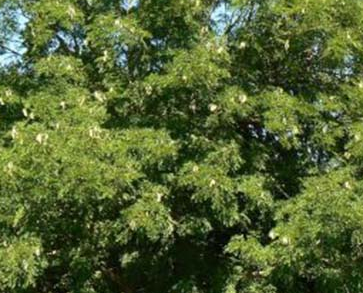The name of this Kentucky coffee tree is derived from the little brown fruits that occur on its cylindrical, long seed pods. The fruits resemble coffee beans when they are ripe and dried.
The Kentucky coffeetree is a particularly unusual kind of tree due to its big, woody pods and extremely large leaves that are composed of numerous smaller leaflets. The Kentucky coffeetree is a striking winter ornamental tree because of its irregular shape, twisted branches, unusual bark, and clusters of huge pods that rattle in the wind.
The tree's unusual growth pattern of coarse, climbing branches that frequently create a narrow crown contributes to its attractive appearance throughout the year.
Kentucky Coffee Tree Pros and Cons
The use of this tall, majestic tree as an ornamental landscaping tree in public spaces like parks, golf courses, and other expansive open places is on the rise. Its massive leaves, which are up to 2 feet wide, create a striking visual effect on the landscape once the tree achieves maturity. The Kentucky coffee tree produces a great shade tree and is a wonderful choice for metropolitan locations with room for it to grow and spread out. It is also drought resistant and not too affected by air pollution. Due to this characteristic, this tree is frequently utilized on golf courses, in public parks, and near hospitals.

This tree is problematic because its leaves, seeds, and pulp are poisonous and harmful to humans, animals, and other plants. Springtime sprout consumption is linked to harmful effects. The poison is found in the leaves, the immature sprouts, and the seeds encased in a gelatinous matter.
Kentucky Coffee Tree Growth Rate
The Kentucky Coffee tree matures at a rate that is between moderate to medium, with annual height gains ranging from less than 12 inches to more than 24 inches. The average length of a leaflet is only two inches.
Kentucky coffee trees typically grow to heights of 60 to 80 feet, with some reaching considerably higher. It grows quickly when it's young, and a little pruning also makes it grow more branches. Its development slows as it grows, eventually developing an erect, unevenly shaped crown of remarkable size.
Kentucky Coffee Tree Care
This tree thrives in a variety of soil conditions. It matures at an average age of 100–150 years and grows slowly. Sunlight of at least 6 hours per day is recommended for optimal growth of the Kentucky coffee tree. This tree survives in both clay and sandy loam soil, but it does best in the latter. It is not affected by excessive acidity or alkalinity. It tolerates drought well and does well in arid areas. Planting too close to a swamp or marshy area causes root damage over time.
Extra watering at the tree's base is helpful during prolonged drought. It is highly drought-resistant and does not need any additional watering under normal conditions.
The Kentucky coffee tree is fairly resilient to winter and is not overly sensitive to temperature or humidity. It is unlikely to thrive in growth zones greater than 8. It is best to feed the Kentucky coffee tree with fertilizers that encourage woody, strong growth instead of lots of leaves. Because it is a nitrogen-fixing tree, it is advised to avoid using nitrogen-based fertilizers on it.
Kentucky Coffee Tree Problems
This tree does not suffer from any serious diseases or insect infestations. The big leaves and the subsequent springtime shedding of seed pods contribute to an unsightly "leaf litter" problem. This makes it more suitable for parks and other open areas than for street trees.
The majority of these trees experience some minor insect defoliation, however, this tree doesn't suffer from any "ornamental" illnesses. Kentucky Coffee tree bears fruit in the form of seed pods that are poisonous if eaten uncooked. After roasting, they are brewed to make a coffee alternative.






0 Comments
For comments please reply here.......